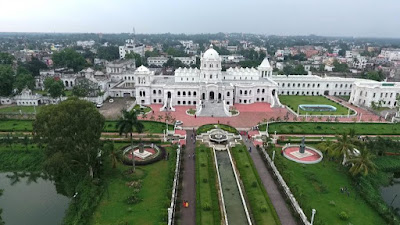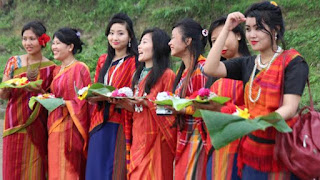Tripura is a state in Northeast
India. The third-smallest state in the country. Bordered by Bangladesh to the
north, south and west, and the Indian states of Assam and Mizoram to the east.
In 2011 the state had 3,671,032 residents, constituting 0.3% of the country's
population. The State of Tripura, with a geographical area of 10,491 sq. km is
predominantly a hilly region. It is surrounded on all sides by a deltaic basin of
Bangladesh except for a small part in North-East which adjoins Cachar district
of Assam and Mizoram.
The origin of the name of Tripura is still a matter of controversy among historians and researchers. According to the 'Rajmala",
Tripura’s celebrated court chronicle, an ancient king named 'Tripura' ruled over
the territorial domain is known as 'Tripura' and the name of the kingdom was
derived from his name.
Many researchers explain the name 'Tripura' from its
etymological origin: the word 'Tripura' is a compound of two separate words,
'tui' (water) + 'pra' (near) which in totality means 'near water'. The geographical location of the state with its close proximity to the vast water
resources of eastern Bengal coupled with the generic identity of the state's
original inhabitants as 'Tipra' or 'Twipra' apparently justify this explanation
of the State's name.
History
Tripura has a long historic past,
a unique tribal culture, and a fascinating folk-lore. The history of Tripura can
be studied from the Rajmala chronicles of the Tripura kings and writings of
other Mohammedan historians. There are references to Tripura even in Mahabharata
and Purans.
The origin of the name Tripura is a highly debated issue. According
to Rajmala, Tripura was once ruled by king Tripur after whom the state has been
named. This opinion has been challenged by many historians and scholars as
well. They claim that the king Tripura was an imaginary figure and no historical
basis can be ascribed to this fact.
Some writers have observed that the name Tripura
derives from the Goddess Tripura sundari- the presiding deity of the land.
Hunter in his book- "A statistical account of Bengal" - observed that
the name Tripura was probably given to the state in honor of the temple at
Udaipur which was dedicated either to Tripuradana, "The sungod", or
to Tripureswari,-"the mistress of the three worlds. The history of Tripura
dates back to the Mahabharata, the Purans and pillar inscription of emperor
Ashoka.
There are no historical records available of Tripura except Rajmala
which is the chronicle history of the rulers of Tripura. According to it, early
rulers were known by the surname "Fa" meaning "father".
There is a reference of rulers of Bengal helping Tripura kings in the
fourteenth century. Kings of Tripura had to face frequent Mughal invasions with
varying successes.
They defeated the Mohammedan sultans of Bengal in several
battles. The nineteenth century marked the beginning of the modem era in Tripura
when king Maliaraja Birchandra Manikya Bahadur modeled his administrative setup
on the British India pattern and brought in various reforms.
His successor
ruled over Tripura till 1947 when it was annexed to the Indian Union on August
13, 1947 through the final integration was effected on October 13, 1947, as a part
of the "C" category state. The Tripura Territorial Council, a body of
elected representatives of the people were first formed on August 15, 1957, under
the provision of the Territorial Act, 1956, Tripura became a centrally
administered Union Territory of India on 1st July 1963 and on the 21st January,
1972, it attained the states of a full-fledged state and Late Sri Shachindra
Lai Singh was the first Chief Minister of the state.
People
The small State of Tripura has a large diversity of tribal peoples. There are around nineteen tribal
communities: Tripuri, Reang, Jamatia, Chakma, Halam, Mog, Kuki, Noatia, Garo,
Munda, Lushai, Oraon, Santhal, Uchai, Khasi, Bhil, Chaimal, Lepcha and Bhutia
TRIPURI:
This is the largest
tribe in Tripura, comprising 55 percent of the tribal population in 2001.
Tripuris are concentrated in West District with a few people in North and South
Districts. Debbarma and Choudhury are used as surnames by Tripuris. Tripuris
belong to the Bode group of Indo-Mongloid origin, and their mother tongue
belongs to the Kokborok linguistic group.
REANG:
The Reangs comprise the
second biggest tribe in Tripura. Reangs also live in Mizoram and Assam. Their
language Kau Bru is distinct from Kokborok, and belongs to the Tibeto–Burman
family of languages. One half of the population of Reangs resides in North
District, the remaining are in South and Dhalai districts. Reangs have been
termed a ‘primitive tribe’ by the Government of India.
JAMATIA:
The Jamatias, the third
largest tribal group in Tripura, are Kokborok-speaking people. Almost 80 percent of Jamatias are found in the South District. The tribe has a distinctive
community organization termed Hoda.
CHAKMA:
Chakmas are a Scheduled
Tribe in Tripura, Mizoram, Assam, Meghalaya and West Bengal. In Tripura, Chakmas
are concentrated in the northern part of the State. Their language, Chakma, is
Indo–Aryan. Most Chakmas are Buddhists.
HALAM:
Halams are considered to
be a Kuki group. In Tripura, Halams are concentrated in the southern and
western part of the State. The tribe has four main sub-groups or dafas, namely,
Halam Kaipeng, Halam Kaloi, Halam Molsom and Halam Rupini. The Halam Kaipeng
and Halam Molsom speak the Halam language, while the Halam Kaloi and the Halam Rupini
speak Kokborok.
MOG:
Mogs are said to have
migrated from Myanmar via the Arakan Hills and the Chittagong Hill Tracts, and
are spread all over the State with the maximum density in South District. Mogs
speak the Magh language, belonging to the Tibeto–Chinese family of languages,
and use the Burmese script.
Physiography
The hill ranges in the State
encountered as one move from west to east are the Baramura–Debtamura Range,
the Atharamura Range, the Longtharai Range, the Shakhan Range, and the Jampui Range.
Belting Shib (939 meters), situated in the Jampui Range, is the highest peak of
Tripura.
Valleys such as Khowai, Dhalai, Manu, and Deo are situated between the
main hill ranges of Tripura. The uplands are interspersed by small isolated
hillocks that are known locally as tillas. The alluvial plains of Tripura
include the narrow valleys, locally known as lungas, that lie mainly in the
western part of the State.
The lungas are fertile and rice is cultivated here.
There are very few flood plains in Tripura; they are mostly located in the west
and south and form the main agricultural lands of the State. There are
marshes, and both natural and artificial lakes, in the plains.
A number of
west-, north- and south-flowing rivers originate in the hills of Tripura and
flow into Bangladesh. The westward-flowing Gomati is the longest and most
important river of the State. A hydroelectric power plant has been set up by
harnessing the Gomati at Dumbur Falls.
Natural gas deposits are among the most important
features of Tripura’s natural resource base. Natural gas has been struck in the
Baramura Hills and in Rokhia in South District, and natural gas-based thermal
power plants have been set up at both places. The hills of Tripura have red
laterite soil which is porous and lacks essential mineral salts, so that
irrigation and fertilizers are needed to make it suitable for cultivation.
The
flood plains and narrow valleys of the State have alluvial soil. However, the
alluvial soil is sandy, lacks the capacity for water retention, and is poor in
humus and essential nutrients. Although Tripura is a land-locked State, since
it is situated only about 60 km to the north of the Bay of Bengal, the sea
influences the climate.
The highest temperatures recorded in the Agartala
Observatory in the height of summer in April and May range between 35°C and
37°C. In January, the coldest month of the year, the mean temperature of the state seldom goes down below 10°C. Tripura experiences very heavy rain from
June to September/October from the South West Monsoon. Winters are mostly dry. The
annual average rainfall of the State is 225 cm.
To
study more about the Geography of Tripura some
books recommendation given below. These are also used as references for this
article. So, I highly recommend you go through these books. For details click
the book title.


